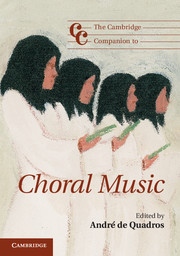Book contents
- Frontmatter
- 1 Introduction: choral music – a dynamic global genre
- Part I Choral music: history and context
- Part II Choral music the world over
- Part III Choral philosophy, practice, and pedagogy
- 15 Globalization, multiculturalism, and the children's chorus
- 16 Exploring the universal voice
- 17 Authentic choral music experience as “good work”: the practice of engaged musicianship
- 18 The making of a choir: individuality and consensus in choral singing
- 19 A point of departure for rehearsal preparation and planning
- 20 Small ensemble rehearsal techniques for choirs of all sizes
- Notes
- Select bibliography
- Index
- Cambridge Companions to Music
16 - Exploring the universal voice
from Part III - Choral philosophy, practice, and pedagogy
Published online by Cambridge University Press: 28 September 2012
- Frontmatter
- 1 Introduction: choral music – a dynamic global genre
- Part I Choral music: history and context
- Part II Choral music the world over
- Part III Choral philosophy, practice, and pedagogy
- 15 Globalization, multiculturalism, and the children's chorus
- 16 Exploring the universal voice
- 17 Authentic choral music experience as “good work”: the practice of engaged musicianship
- 18 The making of a choir: individuality and consensus in choral singing
- 19 A point of departure for rehearsal preparation and planning
- 20 Small ensemble rehearsal techniques for choirs of all sizes
- Notes
- Select bibliography
- Index
- Cambridge Companions to Music
Summary
Few things come more naturally to us humans than producing vocal sounds. Beginning at birth with our first breath and cry, we use our voices to express ourselves and convey our needs. Babies instinctively explore a wide array of vocal sounds, sometimes for the sheer joy of hearing their own voices. As they are enculturated, children are encouraged to imitate the spoken and sung sounds they hear. This universal process has yielded not only different languages, but also an array of vocal timbres used in speaking and singing around the globe, each reflecting cultural preferences and context.
The vocal timbre that evolved to dominate Western choral music is rooted in the Italian vocal technique called bel canto. Today bel canto (discussed below) is employed around the globe, leading Western musicians to assume that it thrives because it is the preferred vocal technique across cultures. However, its wide dissemination results from its alignment with European colonization, Christianization, and imperialism. In many countries, a Western musical education is the only formal accredited study of music available, and the only option for voice training is with teachers trained in bel canto technique.
Despite this, numerous other singing traditions around the globe – including in the United States and Europe – have thrived for centuries. Once never heard outside of their native contexts, today diverse vocal styles are finding their way into the Western choral repertory as a result of travel by individual musicians and touring ensembles.
- Type
- Chapter
- Information
- The Cambridge Companion to Choral Music , pp. 216 - 237Publisher: Cambridge University PressPrint publication year: 2012



